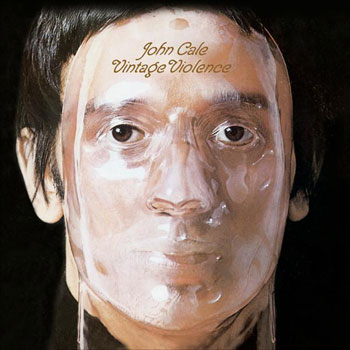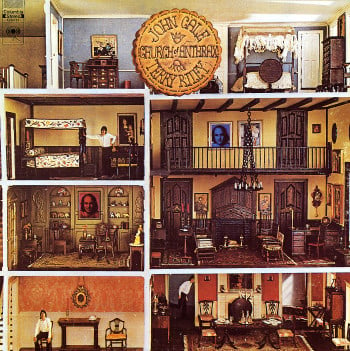

After John Cale left the Velvert Underground I doubt anybody expected his first solo album to be a piece of sophisticated and lushly arranged pop music. Vintage Violence (1970) is a great record which shows almost no signs of any of his previous work either in the world of avant-garde classical composition or with the Velvet Underground. Instead it's a clean break and a brilliant declaration of Cale's casual skill with music in any form. It almost feels like he's saying that it's all just so easy to do, yet there's nothing off-putting about Vintage Violence, it's simply a great pop album with some charming songs and an enticingly casual atmosphere. Unlike on his later albums, there are no challenging elements, every song is a charm, and although his lyrics are as cryptic as they would ever be, even the interpretation-defying nature of most of the songs is in no way a problem. It's a really lovely record and one that I think desreves a bit of a reassessment to rank it with the later Paris 1919 and Fear. The year before the release of Vintage Violence Cale had collaborated with fellow avant-garde composer Terry Riley and recorded Church of Anthrax in 1971. When listening to Cale's work one should really do Church of Anthrax first having been written and recorded before Vintage Violence - but that's the nature of a chronological discography, got to listen in release order... Church of Anthrax is an interesting record, very different to the rest of Cale's catalogue and easily the closest to his training in the avant-garde. Three lengthy pieces dominate the record, the first title piece involving a pulsing bassline and discordant woodwind which is a fascinating piece and in some ways pre-empts a lot of modern classical's future collision with rock structures. The second, 'The Hall of Mirrors at the Palace of Versailles', is a more restrained, and longer, piece and is in nature interestingly similar to a lot of New Age type of stuff that Wyndham Hill would start putting out a few years later, although possibly slightly more discordant than the Wyndham Hill taste would allow. There are two less successful shorter pieces (one with vocals which is a terrible mis-step) and another 12-minute job which is great. The whole record needs to be listened to outside of any rock or pop expectations and as a piece of modern classical and, as such, it's pretty effective.


I haven't got the next couple of albums so move directly to the big one, Paris 1919 (1973). This is deservedly recognised as Cale's high point, it's an extraordinary rock album, filled with great pop hooks and straightforward fundaments of rock music, but it's also possibly the most esoteric straight rock album ever made. It's lyrically cryptic and allusive and the whole thing exudes an air of the most off-hand braininess, which doesn't in any way interrupt the pop smarts that frame it all. Quite apart from being awfully smart, it also has some of the best songs Cale has ever written, from the gentle ('Hanky Panky Nohow') to the genteel ('Graham Greene') to the rockin' ('Macbeth'). The title track for instance is an object lesson in how if you're smart enough you can bring the most awkward influences to bear on pop music. The Reichian piano stabs that merge into string stabs underpin a minimalist bit of horn arrangement, while Cale sings a typically impenetrable lyric, yet the whole thing sounds like a pop song. It's quite, quite brilliant, as is the rest of the album. It's one of the true greats of the 1970's - I had it as the 15th best of the 70's in a list I did a while back (for the record, we've also already the 14th (the Beach Boys Holland) and the 2nd (Bowie's Low).

Cale didn't retain the services of most of Little Feat, who done such a great job on Paris 1919, for the follow up, 1974's Fear. Instead he used Eno and Phil Manzanara of Roxy Music (and on one song, the almighty Richard Thompson) to beef up the sound, and as a result Fear has a much less nostalgic or romantic feel about it than Paris 1919. Instead, the rock element is worked to the fore this time around, together with some mild signs of Cale's developing taste to add a little psychosis to his albums. The opening track, 'Fear is a Man's Best Friend' for instance starts off as a gentle piano led pop song but by the end it's basically a bass being pummelled and Cale screeching the title over and over. It's great, but unexpected, and when it's followed by another gentle piano led song (the lovely 'Buffalo Ballet') you're already on edge about where each song might go. Really though, it's only 'Fear Is a Man's Best Friend' and the opener of side 2, 'Gun', on which Cale and his band lets rip. The rest of the album is composed of really great gentler rock songs, 'Ship of Fools', 'Emily' and 'You Know More Than I Know' being particular stand-outs. It's a fantastic album, only slightly behind Paris 1919 in quality. Next was Slow Dazzle (1975), and this is where it's clear that Cale has peaked and is beginning to come back down. It's not a bad record by any means, in fact it's really very fine, but it's uneasy and there are songs that just don't really work. In some ways it feels a bit like a work in progress, a bit too rock 'n' roll focussed, not delicate enough somehow. It does contain possibly the bleakest ever cover version in Cale's absolute emotional evisceration of 'Heartbreak Hotel', which is impressive not only in its brilliance of execution and daring but also in its depth of jet-black misery. Bearing in mind this is the album Cale made after finding Kevin Ayers having it off with his wife (the song 'Guts' opens with the line "The bugger in the short sleeves fucked my wife") it's no surprise that it's both a little haphazard and relatively grim.


Calexico's first album, Spoke (1997) is a charming collection of low-key dustbowl vignettes. There's little of the strident mariachi or indie rock meets dustbowl blues confidence of their later albums. Spoke has more clearly come out of Joey Burns and John Convertino's tenure backing Howe Gelb in Giant Sand and the affinities between Gelb's albums at the time and Spoke are very clear. It's really lovely stuff, all fractured Americana and mid-western folk but it doesn't demand your attention and because the varied songs and instrumental pieces all feel like they exist in something of a vacuum I never really have the strong sense that Spoke is an album as such rather than a collection of really nicely understated mood pieces.

I think the band really found their identity with second album The Black Light (1998). This is a much more strident record, fuller, and more solidly written and performed. There are still plenty of short mood pieces but they punctuate much more fleshed out songs, and the instrumentation is fuller. Stylistically the whole record is much more cohesive, with the martial drumming and mariachi accordion playing key roles throughout, and the idea that the band's very name evokes is more explicit in the songs and instrumental pieces. People have often mis-used Ennio Morricone as a reference point (the insistence on using Morricone's four or five Western soundtracks as shorthand really bugs me. Morricone has written over 400 scores of a breathtaking variety of styles so why he should be saddled with a specific reputation because of The Good, the Bad and the Ugly mystifies me) but I think its much more useful to look at Calexico's records as being an indie filtered fusion of light mariachi and modern Americana. Better than The Black Light by some way is, to my mind, the best record they've made to date, Hot Rail (2000). It's similar in theme and style to The Black Light, but there are less atmosphere setting pieces, it's much more song based, and the songs themselves are much more confident and striking. Where The Black Light tends to meander, Hot Rail keeps moving. Some of these are really great songs too. It all feels bigger, more solid and assured and it's a compelling listen. Finally for today is the double 7" that they released in 2001, 'The Crystal Frontier', which is a great tune, better than everything on any of the albums up to this point, all parping horns, and propulsive mariachi guitar, and there's a nice cover of American Music Club's 'Chanel No.5', together with two equally decent new songs.



No comments:
Post a Comment